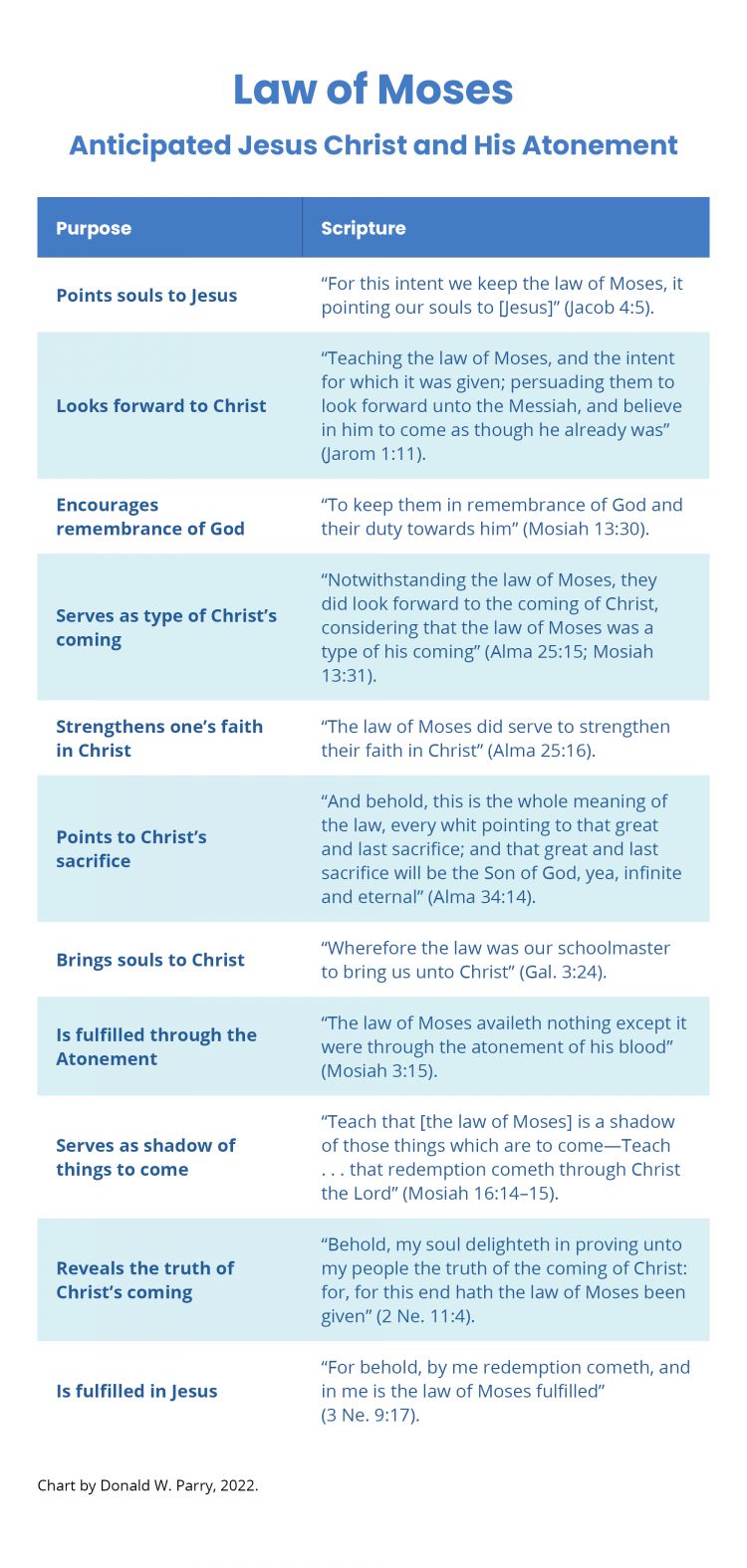You are here
Law of Moses: Anticipated Jesus Christ and His Atonement
| Title | Law of Moses: Anticipated Jesus Christ and His Atonement |
| Publication Type | Book Chapter |
| Year of Publication | 2022 |
| Authors | Parry, Donald W. |
| Book Title | The Jesus Christ Focused Old Testament: Making Sense of a Monumental Book |
| Chapter | 46 |
| Pagination | 124-125 |
| Publisher | Book of Mormon Central |
| City | Springville, UT |
Show Full Text
During a portion of the Old Testament time period, the law of Moses helped focus the Israelites’ attention on Jesus Christ and His Atonement. The law of Moses was a set of regulations, directives, and ordinances that encouraged Israelites to “look forward to the coming of Christ, considering that the law of Moses was a type of his coming” (Alma 25:15; emphasis added) and that its intent was to persuade them “to look forward unto the Messiah, and believe in him to come as though he already was” (Jarom 1:11). Paul emphasized that the law of Moses was “our schoolmaster to bring us unto Christ” (Gal. 3:24). And the book of Alma recorded that the righteous Lamanites “did not suppose that salvation came by the law of Moses; but the law of Moses did serve to strengthen their faith in Christ” (Alma 25:16).
Furthermore, Amulek instructed his listeners, “And behold, this is the whole meaning of the law [of Moses], every whit pointing to that great and last sacrifice; and that great and last sacrifice will be the Son of God” (Alma 34:14). Whit in this passage means “particle, bit, jot.” Every whit or particle of the law of Moses, therefore, testified of Jesus and His sacrifice, including the following: temple rituals, the system of sacrifices, the annual feasts and festivals, and laws pertaining to the military, family, commerce, the administration of justice, personal injuries, and more.
Speaking of the law of Moses, Elder Holland wrote, “This historic covenant, given by the hand of God himself and second only to the fulness of the gospel as an avenue to righteousness, should be seen . . . as the unparalleled collection of types, shadows, symbols, and prefigurations of Christ that it is. For that reason it was once (and still is, in its essence and purity) a guide to spirituality, a gateway to Christ.”[1]
|
Purpose |
Scripture |
|---|---|
|
Points souls to Jesus |
“For this intent we keep the law of Moses, it pointing our souls to [Jesus]” (Jacob 4:5). |
|
Looks forward to Christ |
“Teaching the law of Moses, and the intent for which it was given; persuading them to look forward unto the Messiah, and believe in him to come as though he already was” (Jarom 1:11). |
|
Encourages remembrance of God |
“To keep them in remembrance of God and their duty towards him” (Mosiah 13:30). |
|
Serves as type of Christ’s coming |
“Notwithstanding the law of Moses, they did look forward to the coming of Christ, considering that the law of Moses was a type of his coming” (Alma 25:15; Mosiah 13:31). |
|
Strengthens one’s faith in Christ |
“The law of Moses did serve to strengthen their faith in Christ” (Alma 25:16). |
|
Points to Christ’s sacrifice |
“And behold, this is the whole meaning of the law, every whit pointing to that great and last sacrifice; and that great and last sacrifice will be the Son of God, yea, infinite and eternal” (Alma 34:14). |
|
Brings souls to Christ |
“Wherefore the law was our schoolmaster to bring us unto Christ” (Gal. 3:24). |
|
Is fulfilled through the Atonement |
“The law of Moses availeth nothing except it were through the atonement of his blood” (Mosiah 3:15). |
|
Serves as shadow of things to come |
“Teach that [the law of Moses] is a shadow of those things which are to come—Teach . . . that redemption cometh through Christ the Lord” (Mosiah 16:14–15). |
|
Reveals the truth of Christ’s coming |
“Behold, my soul delighteth in proving unto my people the truth of the coming of Christ: for, for this end hath the law of Moses been given” (2 Ne. 11:4). |
|
Is fulfilled in Jesus |
“For behold, by me redemption cometh, and in me is the law of Moses fulfilled” (3 Ne. 9:17). |
Terms of Use
Items in the BMC Archive are made publicly available for non-commercial, private use. Inclusion within the BMC Archive does not imply endorsement. Items do not represent the official views of The Church of Jesus Christ of Latter-day Saints or of Book of Mormon Central.
Bibliographic Citation
Subscribe
Get the latest updates on Book of Mormon topics and research for free

